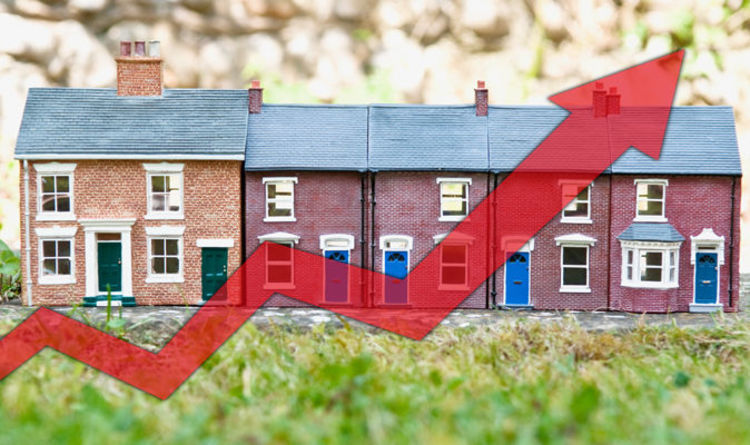Rightmove’s first housing market report of 2022 starts when last year’s ended – on a high.
The average price of property coming to market jumps by 0.3 per cent this month to £341,019, which is 7.6 per cent higher than a year ago and is the highest annual rate of price growth recorded by Rightmove since May 2016.
First-time buyer asking prices hit a new record of £214,176 after a monthly jump of 1.4 per cent.
Strong demand and continuing low numbers of available homes for sale set up the housing market frenzy to continue into the start of 2022, with early-bird sellers benefitting from increased buyer competition.
The number of buyers enquiring about homes is 15 per cent higher than the same time last year, yet the number of available homes for sale per estate agency branch drops again to a new record low of just 12.
As a result, Rightmove calculates that competition among buyers is almost double what it was at this time last year.
However, the portal reports that there are early signs that more property choice is on its way, with the first working week of 2022 being the busiest start of the year ever for people requesting agents to come out and value their homes: the number of home valuation requests is 44 per cent up on the same period last year, and 48 per cent up on the same period in 2020.
Tim Bannister, Rightmove’s director of property data, comments: “New Year sellers and buyers have been quick off the mark this year, with Rightmove recording the highest ever number of Boxing Day sellers coming to market.
“These early-bird sellers who got themselves ready to come to market are now benefitting from the busiest start to the year that we’ve ever recorded, with the number of prospective buyers enquiring about homes up 15% on this time last year.
“All of the signs suggest that prices are likely to continue to rise until more choice is available. Three regions are in most urgent need of new supply, the East Midlands, South West and South East of England, as they are now at unsustainable rates of annual price growth above 10 per cent.”
He continues: “Almost 40 per cent of people enquiring about a home who have a property to sell say that they are yet to put it on the market. In the current market, where they are competing against others who are able to move more quickly, this is likely to mean they’ll miss out on the home they want. To put yourself in the best possible position to proceed, you should become a ‘power buyer’, by making sure your current home is on the market or preferably sold subject to contract first, before starting the search for your new home.”
Average Rents up for Fifth Quarter in a Row
Average UK rents increased for the fifth consecutive quarter during Q4 2021, according to data collected by The Deposit Protection Service (DPS).
Average rents reached £834 during the final three months of 2021, an increase of £16 (1.96%) on the previous quarter and a £42 or 5.30% increase on Q3 2020.
South West rents, which traditionally lag behind the national average, drew level for the first time, rising by £19 (2.33%) during Q4 2021, and by £54 (6.92%) from £780, the largest regional percentage increase during the past 12 months.
Average rents have increased across all property types since Q3 2021, with those on detached properties increasing the most; on average by £26 (2.33%) to £1,143, and also rising £88 or 8.34% from Q3 2020.
The organisation also said that Q4 2021 rents also rose across most of England, with London, the South West, and Yorkshire seeing the largest value rises, contributing to an annual UK average rent increase of just over 4% for 2021.
York saw one of the highest increases, up £71 (9.49%) from £748 to £819 during Q4 2021, a rise of £120 or 17.17% from £699 since Q4 2020.
Conversely, Southampton saw one of the largest falls in rental value during Q4 2021, decreasing £122, (15.12%) from £807 to £685.
Average rents in the North East, traditionally one of the cheapest regions in the UK to rent, increased by £5 (0.91%) from £549 to £554 during Q4 2021, with rents increasing £34 (6.54%) during the past 12 months.
During Q4 2021 London rents increased for the second consecutive quarter, ending 2021 at £1,381, an increase of £42 (3.14%), the highest value regional increase, and a £64 (4.86%) increase on the same quarter during 2020.
The London borough of Islington saw the sharpest value rise in rent during Q4 2021, an increase of £273 (19.6%), from £1,393 to £1,666, added the organisation.
Matt Trevett, managing director at The DPS, said: “During Q4 2021 rents increased in the vast majority of UK regions and across all property types, with demand for detached properties driving the greatest increase in rental value for these properties.
“Our figures also show that renters were less likely to move during the past 12 months, suggesting lower availability of stock and therefore perhaps more limited options for moving.
“We’re also seeing definitive signs of recovery in London, particularly the return of the popularity of flats in some areas, suggesting that some tenants are coming back to the capital.”
Paul Fryers, managing director of Zephyr Homeloans, added: ”There is currently significant pressure on rental stock across the country.
“Reasons are complex, but they include landlords selling up to capitalise on high sale prices, plus a shortage of new build homes as a result of supply chain and raw materials issues.
“We’re hearing stories of landlords receiving unprecedented levels of interest, with some renters willing to pay rents upfront and even stories of some tenants willing to pay over the odds to secure properties.”

